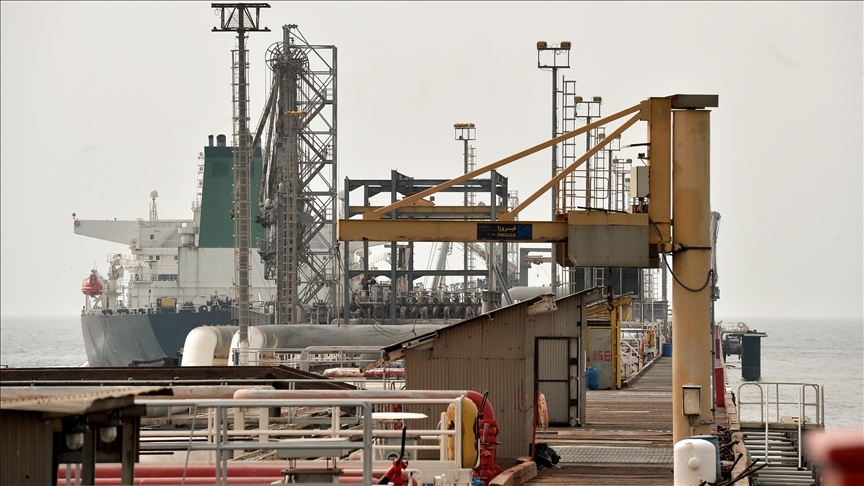China faces oil supply risk if Israel-Iran conflict escalates
Beijing imports 45% of its oil through Strait of Hormuz, which Iran threatens to block amid rising tensions
 A general view of the Port of Kharg Island Oil Terminal, 25 km from the Iranian coast in the Persian Gulf and 483 km northwest of the Strait of Hormuz, in Iran on March 12, 2017. Kharg Island Oil Terminal brings Iranian oil to the world market. The oil terminal is the world's largest open oil terminal, with 95% of Iran's crude oil exports coming through it. ( Fatemeh Bahrami - Anadolu Agency )
A general view of the Port of Kharg Island Oil Terminal, 25 km from the Iranian coast in the Persian Gulf and 483 km northwest of the Strait of Hormuz, in Iran on March 12, 2017. Kharg Island Oil Terminal brings Iranian oil to the world market. The oil terminal is the world's largest open oil terminal, with 95% of Iran's crude oil exports coming through it. ( Fatemeh Bahrami - Anadolu Agency )
BEIJING
China could face major oil supply disruptions if war between Israel and Iran escalates further, as Beijing remains heavily reliant on crude oil imports from the Middle East, much of which transits through the vulnerable Strait of Hormuz.
China is the world’s largest oil importer. In 2024, it produced 4.3 million barrels of crude oil per day but imported 11.1 million barrels, according to the US Energy Information Administration.
Nearly 45% of China’s total oil imports pass through the Strait of Hormuz, the narrow maritime chokepoint connecting the Persian Gulf to the Arabian Sea, which Iran has repeatedly threatened to close in response to Israeli military strikes.
According to commodity intelligence firm Kpler, China accounts for 90% of Iran’s oil exports. Official Chinese customs data lists top suppliers as Russia (2.1 million barrels per day), Saudi Arabia (1.5 million), and Malaysia (1.4 million), but Iranian oil is absent from the reports due to US-led sanctions.
Estimates suggest China imports more than 4.9 million barrels per day from Middle Eastern producers, including Saudi Arabia, Iraq, Oman, the United Arab Emirates, Kuwait and Qatar.
Geopolitical flashpoint
The International Energy Agency warned in its June 2024 report that rising tensions between Israel and Iran pose serious risks to the global oil market.
Israel has launched multiple airstrikes on Iran’s energy infrastructure in recent weeks, including attacks on the South Pars gas field — partially halting operations — and the Shahran oil depot near Tehran.
Iran has warned it may block the Strait of Hormuz if further attacks occur. The waterway accounts for about 25% of global oil trade and is a key route for exports from Saudi Arabia, the UAE, Kuwait, Qatar, Iraq and Iran to Asian markets.
Analysts warn that even a brief disruption in traffic through the strait could trigger major supply chain shocks and sharp oil price spikes.
Iran’s oil under sanctions
Iran produces an estimated 4.8 million barrels of oil daily, while importing about 2.5 million barrels, according to the IEA. Since early 2025, the country’s imports have included 1.7 million barrels of crude and 800,000 barrels of refined products per day.
Due to US nuclear sanctions, Iran has limited formal export partners and reportedly ships oil to sanctioned markets such as Syria, Venezuela and Afghanistan, in addition to China. Some exports are believed to be routed through the United Arab Emirates for processing.
To evade sanctions, Iran is accused of using a so-called “shadow fleet” of tankers sailing with transponders disabled. Chinese private refineries — mainly in Shandong province — are reported to handle these imports, avoiding large state-owned oil companies.
Iranian oil is typically sold below market price due to sanctions. While this discount once created strong profit margins, analysts note a sharp decline: from $11 per barrel in 2023 to $4 in 2024, and just $2 so far in 2025.
Several reports indicate that Iran sells oil in Chinese yuan instead of US dollars, restricting its purchases to Chinese goods.
Anadolu Agency website contains only a portion of the news stories offered to subscribers in the AA News Broadcasting System (HAS), and in summarized form. Please contact us for subscription options.







